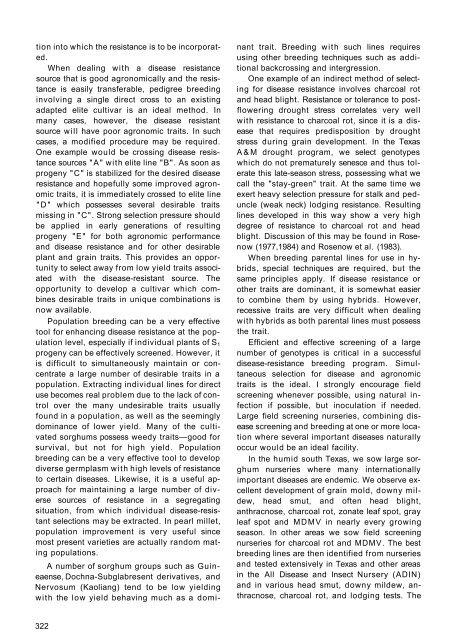Sorghum Diseases in India
Sorghum Diseases in India
Sorghum Diseases in India
Create successful ePaper yourself
Turn your PDF publications into a flip-book with our unique Google optimized e-Paper software.
tion <strong>in</strong>to which the resistance is to be <strong>in</strong>corporated.<br />
When deal<strong>in</strong>g with a disease resistance<br />
source that is good agronomically and the resistance<br />
is easily transferable, pedigree breed<strong>in</strong>g<br />
<strong>in</strong>volv<strong>in</strong>g a s<strong>in</strong>gle direct cross to an exist<strong>in</strong>g<br />
adapted elite cultivar is an ideal method. In<br />
many cases, however, the disease resistant<br />
source will have poor agronomic traits. In such<br />
cases, a modified procedure may be required.<br />
One example would be cross<strong>in</strong>g disease resistance<br />
sources "A" with elite l<strong>in</strong>e "B". As soon as<br />
progeny "C" is stabilized for the desired disease<br />
resistance and hopefully some improved agronomic<br />
traits, it is immediately crossed to elite l<strong>in</strong>e<br />
"D" which possesses several desirable traits<br />
miss<strong>in</strong>g <strong>in</strong> "C". Strong selection pressure should<br />
be applied <strong>in</strong> early generations of result<strong>in</strong>g<br />
progeny "E" for both agronomic performance<br />
and disease resistance and for other desirable<br />
plant and gra<strong>in</strong> traits. This provides an opportunity<br />
to select away from low yield traits associated<br />
with the disease-resistant source. The<br />
opportunity to develop a cultivar which comb<strong>in</strong>es<br />
desirable traits <strong>in</strong> unique comb<strong>in</strong>ations is<br />
now available.<br />
Population breed<strong>in</strong>g can be a very effective<br />
tool for enhanc<strong>in</strong>g disease resistance at the population<br />
level, especially if <strong>in</strong>dividual plants of S1<br />
progeny can be effectively screened. However, it<br />
is difficult to simultaneously ma<strong>in</strong>ta<strong>in</strong> or concentrate<br />
a large number of desirable traits <strong>in</strong> a<br />
population. Extract<strong>in</strong>g <strong>in</strong>dividual l<strong>in</strong>es for direct<br />
use becomes real problem due to the lack of control<br />
over the many undesirable traits usually<br />
found <strong>in</strong> a population, as well as the seem<strong>in</strong>gly<br />
dom<strong>in</strong>ance of lower yield. Many of the cultivated<br />
sorghums possess weedy traits—good for<br />
survival, but not for high yield. Population<br />
breed<strong>in</strong>g can be a very effective tool to develop<br />
diverse germplasm with high levels of resistance<br />
to certa<strong>in</strong> diseases. Likewise, it is a useful approach<br />
for ma<strong>in</strong>ta<strong>in</strong><strong>in</strong>g a large number of diverse<br />
sources of resistance <strong>in</strong> a segregat<strong>in</strong>g<br />
situation, from which <strong>in</strong>dividual disease-resistant<br />
selections may be extracted. In pearl millet,<br />
population improvement is very useful s<strong>in</strong>ce<br />
most present varieties are actually random mat<strong>in</strong>g<br />
populations.<br />
A number of sorghum groups such as Gu<strong>in</strong>eaense,<br />
Dochna-Subglabresent derivatives, and<br />
Nervosum (Kaoliang) tend to be low yield<strong>in</strong>g<br />
with the low yield behav<strong>in</strong>g much as a domi-<br />
322<br />
nant trait. Breed<strong>in</strong>g with such l<strong>in</strong>es requires<br />
us<strong>in</strong>g other breed<strong>in</strong>g techniques such as additional<br />
backcross<strong>in</strong>g and <strong>in</strong>tergression.<br />
One example of an <strong>in</strong>direct method of select<strong>in</strong>g<br />
for disease resistance <strong>in</strong>volves charcoal rot<br />
and head blight. Resistance or tolerance to postflower<strong>in</strong>g<br />
drought stress correlates very well<br />
with resistance to charcoal rot, s<strong>in</strong>ce it is a disease<br />
that requires predisposition by drought<br />
stress dur<strong>in</strong>g gra<strong>in</strong> development. In the Texas<br />
A&M drought program, we select genotypes<br />
which do not prematurely senesce and thus tolerate<br />
this late-season stress, possess<strong>in</strong>g what we<br />
call the "stay-green" trait. At the same time we<br />
exert heavy selection pressure for stalk and peduncle<br />
(weak neck) lodg<strong>in</strong>g resistance. Result<strong>in</strong>g<br />
l<strong>in</strong>es developed <strong>in</strong> this way show a very high<br />
degree of resistance to charcoal rot and head<br />
blight. Discussion of this may be found <strong>in</strong> Rosenow<br />
(1977,1984) and Rosenow et al. (1983).<br />
When breed<strong>in</strong>g parental l<strong>in</strong>es for use <strong>in</strong> hybrids,<br />
special techniques are required, but the<br />
same pr<strong>in</strong>ciples apply. If disease resistance or<br />
other traits are dom<strong>in</strong>ant, it is somewhat easier<br />
to comb<strong>in</strong>e them by us<strong>in</strong>g hybrids. However,<br />
recessive traits are very difficult when deal<strong>in</strong>g<br />
with hybrids as both parental l<strong>in</strong>es must possess<br />
the trait.<br />
Efficient and effective screen<strong>in</strong>g of a large<br />
number of genotypes is critical <strong>in</strong> a successful<br />
disease-resistance breed<strong>in</strong>g program. Simultaneous<br />
selection for disease and agronomic<br />
traits is the ideal. I strongly encourage field<br />
screen<strong>in</strong>g whenever possible, us<strong>in</strong>g natural <strong>in</strong>fection<br />
if possible, but <strong>in</strong>oculation if needed.<br />
Large field screen<strong>in</strong>g nurseries, comb<strong>in</strong><strong>in</strong>g disease<br />
screen<strong>in</strong>g and breed<strong>in</strong>g at one or more location<br />
where several important diseases naturally<br />
occur would be an ideal facility.<br />
In the humid south Texas, we sow large sorghum<br />
nurseries where many <strong>in</strong>ternationally<br />
important diseases are endemic. We observe excellent<br />
development of gra<strong>in</strong> mold, downy mildew,<br />
head smut, and often head blight,<br />
anthracnose, charcoal rot, zonate leaf spot, gray<br />
leaf spot and MDMV <strong>in</strong> nearly every grow<strong>in</strong>g<br />
season. In other areas we sow field screen<strong>in</strong>g<br />
nurseries for charcoal rot and MDMV. The best<br />
breed<strong>in</strong>g l<strong>in</strong>es are then identified from nurseries<br />
and tested extensively <strong>in</strong> Texas and other areas<br />
<strong>in</strong> the All Disease and Insect Nursery (ADIN)<br />
and <strong>in</strong> various head smut, downy mildew, anthracnose,<br />
charcoal rot, and lodg<strong>in</strong>g tests. The








